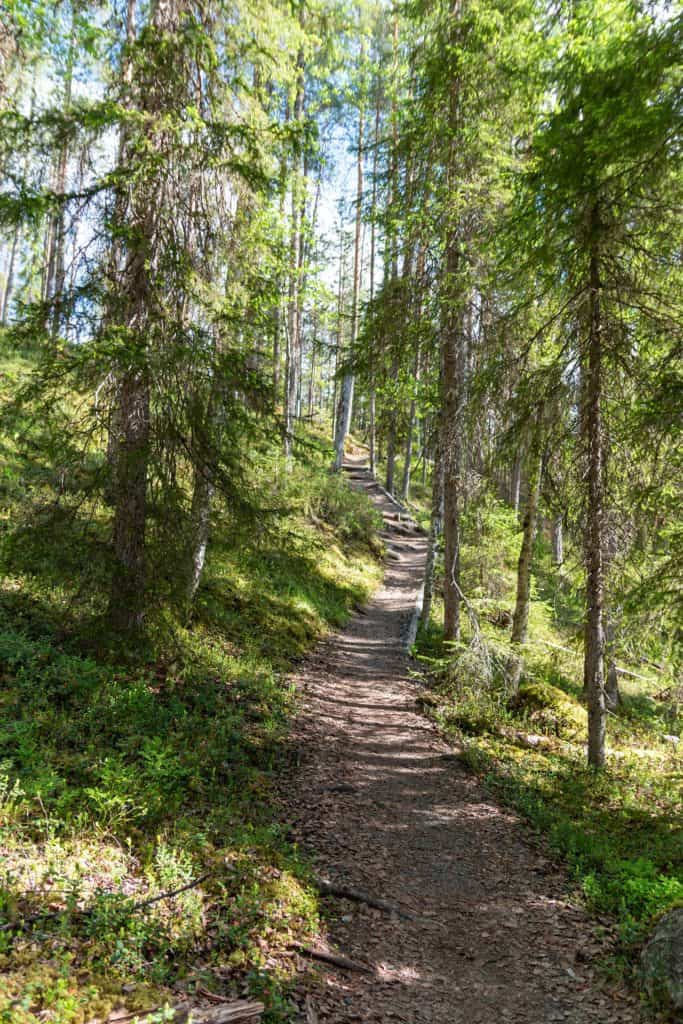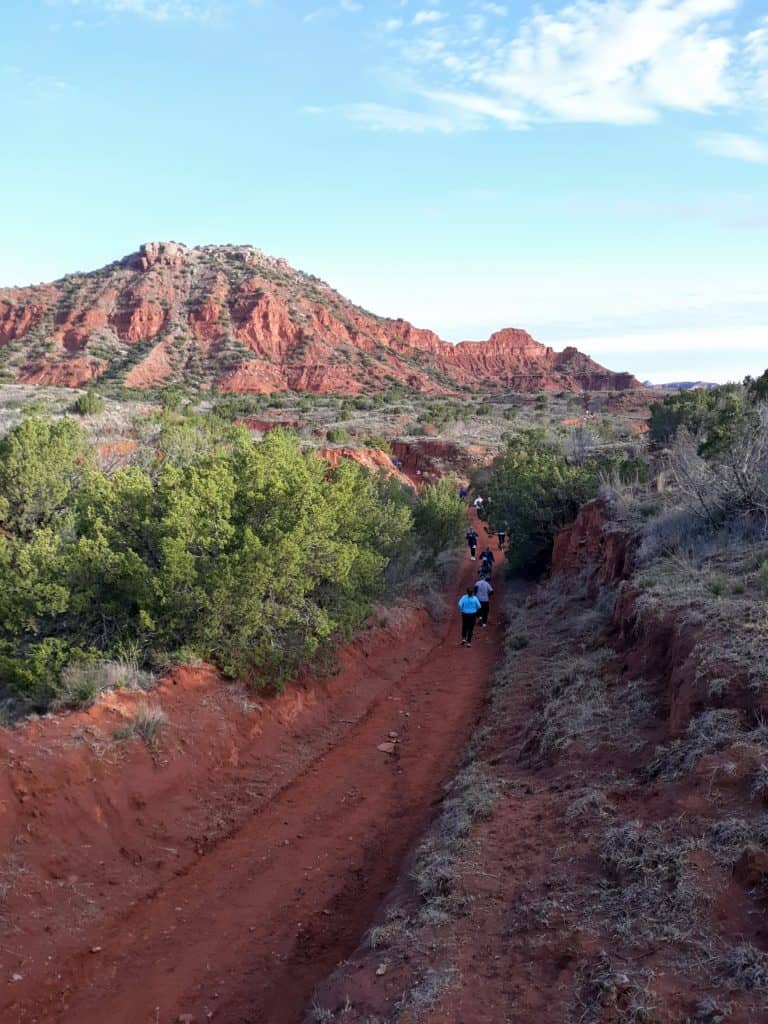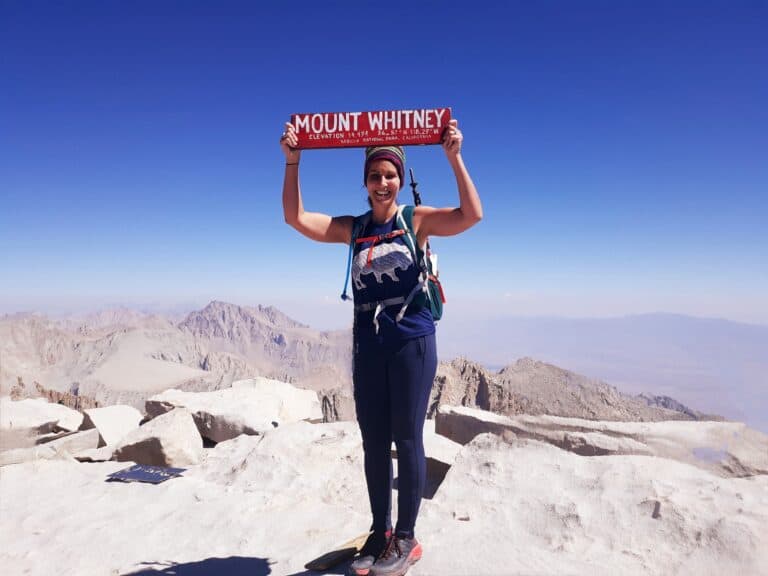Intro to Trail Running: A Complete Beginner’s Guide
So what exactly is trail running versus regular running? What defines a trail runner? What trail running gear is necessary? And how exactly do you start trail running when you are new to trail running? Whether you are a beginning runner, a novice runner, or an experienced runner, eventually you will cross paths with the difference between road running and trail running, and a proper intro to trail running can be very beneficial. Maybe you will be intrigued to try both, or maybe you will find one to be more your calling. Or maybe, like me, you will start off as a road runner, before discovering trail running. Or maybe you’ll find yourself a hiker, and then gradually hike faster and faster until, before you know it, you are running those hikes and are now a trail runner! There’s a lot of niches in the running world, and a lot of different ways to incorporate the unique characteristics of trail running into your active travel lifestyle! So take a look at this guide to trail running for beginners, and discover everything there is to love about trail running!
This intro to trail running will cover:
- The difference between road and trail running
- Understanding trail running terrain
- Trail running locations
- Trail running gear recommendations
- How to develop trail running awareness
- How to start trail running
- Training for a long distance trail running race
Disclosure: Below are some affiliate links-these are all products I highly recommend. I won’t make any recommendations on this page that I haven’t tested or personally used! Enjoy this intro to trail running guide!
Table of Contents
Guide to Trail Running
This guide to trail running covers the basic intro to trail running, plus the differences between trail running and road running, the important trail running gear, and how to start a regular trail running regimen successfully!

What’s the Difference Between Trail Running and Road Running?
So what are the main differences between trail running and road running? The main differences can be broken down into terrain, locations, trail running gear, and awareness.
Speaking from personal experience, I was solely a road runner for a long time, like over a decade long time, before I had my own intro to trail running and incorporated trail running into my routine. I knew it existed, but I never felt up to trying it.
Then, I encountered a bout with early osteoarthritis in my knees, and had to pivot slightly. That pivot included adjusting my road running until I could work out the necessary tweaks to move forward safely. These adjustments, which included slowing down on road running, unexpectedly opened the door to more hiking. And this in turn became part of my guide to trail running.
I started upping my hiking game for that time being, which still allowed me to get my necessary movement in, to cover my necessary miles, and to get me outdoors in new locations. I challenged myself to rest my knees from the impact of running, but to walk as fast as I could to still achieve the adrenaline I was looking for. This morphed into a unique, extremely fast paced brand of hiking that served me well for some time.
It was during that time that I discovered that I really cherished being on trails. It was something different from traversing roads. As my knees adjusted and become stronger, I began to start running parts of those hiking trails. I began to sign up for local trail runs and chip away at 5k and 10k races, to get my feet wet. I leaned on the knowledge and experience of both my road running background and my hiking background, to become a better trail runner. Until, at some point, I went from being new to trail running to trail running becoming a new favorite.
I have learned that as much as I love road running, the same goes for trail running, and I’m glad I’ve had the opportunity to master both. While the movement of your feet may be similar for either, there are many unique things about trail running that set it apart. Below is a guide to trail running and its unique qualities.
Guide to Trail Running Terrain
Trail running is by nature less “predictable”. The terrain is rougher, more uneven, and more challenging, than road running. Trail running happens, no surprise here, on trails. Trails that are made up of gravel, sand, tree roots, jutting rocks and sharp edges, streams, and boulders. They climb mountainsides, wind along beaches, and are often found in many state and National Parks. These challenges are often rewarded with amazing views, changes in scenery, and a course that will keep you engaged and on your toes the whole time.

Guide to Trail Running Locations
As I mentioned above, the locations for trail running races can be stunning, and often, more secluded than many road running races. Many of my favorite trail running races have been on trails that carved along rims of canyons, climbed mountain ridges, paralleled the ocean, or took place in other locations that roads typically don’t go.
So how do I find trail runs near me?
For this reason, trail running races are often hosted by many parks, including state and National Parks. Not that state and National Parks do not also host road running races, because they do (check out this list of best National Park races), but trail running is kind of their speciality.
This is not a hard and fast rule, but generally speaking, trail running has a higher possibility of removing the runner from their normal surroundings, and transplanting them to a location more secluded and away from the grind, surrounded by nature.
Guide to Trail Running Gear
This is a big difference here when new to trail running. Road running and trail running gear should look different. It is totally doable to start trail running with road running gear, but it is more responsible, safer, and more comfortable to fine tune your inventory to trail running gear specifically. Some trail running gear will crossover to road running, but some will not.
Recommended Trail Running Gear Quick Links:
- HOKA One One Speedgoat Trail Runners
- Hilly Twin Skin Socks
- Collapsible Running Cup
- Hydroflask
- Nathan Hydration Running Belt
- Hydration Running Belt with Bottle Holder
- Camelbak Hydration Vest with Bladder
- Solomon Trail Gaiters
- Pocketed Workout Leggings
- Icebreaker Wool Tank
- Long Sleeve Wool Base Layer
- Waterproof and Windproof Outer Shell
Shoes
The most important item of trail running gear by far, in my opinion, are shoes. As previously noted, this is because the terrain is different. The terrain is more challenging, uneven, and unpredictable. This means your trail running shoe needs to be equipped for these differences, with a sole that grips and cushions, with stability.
I’ve run every single road race in Brooks Glycerins road running shoes. however, when I branched over into trail running as well, I did my research, and ultimately tested out a specific trail running shoe, and began running in the best trail running shoe out there, HOKA One One Speedgoats. Their reputation for cushioning, grip, reliability, and performance are unmatched. Look at the shoes of the other runners on the next trail run or hike you do. You will notice a lot of HOKA’s out there!
HOKA’s were a trail running game changer for me, and the HOKA Speedgoat trail runner has not only upped my performance, but it cradles my feet and knees just a little more than my Brooks.
Both these brands are exceptional and have an impeccable reputation among runners. But for performance and cushioning together, my HOKAS outshine just a little more than anything else. I would recommend it to anybody new to trail running with no hesitation, though you should always still test out your shoe and make sure it’s the best for you, because there is no absolute answer for everyone. HOKAS or Brooks are just a good place to start, and possibly, it will be a good place to end as well.
Water Transportation System
A water transportation system is vital no matter whether you are a road runner or a trail runner. However, you have a more likely chance of running supported as a road runner, especially if you are running in a city setting. Trail runners need to ensure their source of hydration equally.
On my road runs, I often run courses that pass city parks equipped with water fountains or such, making the need to carry water on me less crucial. With trail running, however, be sure to do your research ahead of time to determine whether you are running a water supported trail or not.
On more remote trails in state parks or National Parks, you likely will not be supported. If it is an organized race, however, you should be able to determine ahead of time where the aid stations will be, and how much or if you need to carry water on your person as well.
For training purposes, and regular routine runs, count on carrying your own water. Water transportation systems vary depending on your needs. If it is a well supported organized race, you may suffice with just a lightweight, collapsible cup you can fill and drink out of. You can refill a collapsible cup at aid stations. Or maybe a small, canteen like water bottle that can be carried, or fit in the pocket of many deep pocketed running leggings. Or if you have a designated place to leave a bottle and loop back to it, Hydroflasks are great insulated options.
There are also waist bands that are equipped to carry one or two small canteens attached, like this one available on Amazon, that also provide the additional perks of having extra storage to carry small necessities like keys, phones, or chapstick. Or go for a similar style running waistbelt that carries one large water bottle and small personal affects.
For those new to trail running that require something on the heavier end (for long, secluded, and/or non-supported runs), I would highly recommend a water hydration vest. These vests may initially look like a hiker’s backpack, but they are built specifically for trail runners. My favorite hydration vest is this Camelbak model. I trust this brand for both my trail running needs, as well as my day hiking needs (I day hike with a Camelbak model backpack as well).
This particular Camelbak water hydration vest that I recommend has many unique qualities for trail running, versus a regular hiking backpack, despite the visual similarities. First, it comes equipped with a 1.5 liter water bladder. This bladder has a wide mouthed opening, which makes it easy to fill, as well as dry and clean. This smaller bladder size holds a sizeable amount of water perfect for long trail runs, but is small enough to lay flush on a runner’s back, and not create too much bounce. The bladder hose attaches to the front of the vest, making on the go hydration super easy and convenient. There is a storage pocket on the back of the vest adjacent to the bladder, which is great for storing larger items, and items you don’t need constant and immediate access too. However, it also has 5 storage pockets on the front of the vest, for smaller items and quick, uninterrupted access to personal items. These pockets are ideal for holding phones, keys, Chapstick, kleenex, etc. Finally, this water hydration vest has multiple, quick adjustable straps that secure the hydration vest flush with your back and sides, preventing bounce when running. You will be able to hear your water sloshing around when you are running, but this vest will not bounce or slap you in the back!
Socks
In the running game, your shoes are only as good as your socks. A defect in either can completely derail a successful run. For those who are new to trail running specifically, I recommend a lined sock to prevent blisters from the additional friction of running on trails. I used to struggle consistently with any trail run or hike longer than 5 or 6 miles, until I discovered these Hilly Twin Skin lined socks, that counteract the friction and rubbing of trail running. Zero blisters since I began running in these!
Gaiters
Gaiters are something that you will rarely encounter if you have been road running. They are something specifically geared to the trails. When running on trails, there is a much more likely chance you will kick up dirt, sand, rock, gravel, etc., and it is easy to get these materials lodged in your shoe. Nobody wants to lose time digging debris out of your socks and shoes in the middle of a trail run. Gaiters are like little protective “sleeves” that cover your ankle and lower leg area. This is my go to trail running gaiter.
Right Fabrics
Wearing the right fabrics is a foundational basic of all my active travel guides, from road running training plans, to essential hiking basics, to road cycling plans. One of the key concepts of knowing what fabrics TO wear, is knowing what NOT to wear.
Avoid cotton at all costs. Cotton is like a squeegee that soaks up and holds onto moisture, instead of wicking it away. Not only is this uncomfortable in any season and any activity, but it is down right dangerous in cold conditions, as this buildup can turn cold as it clings close to skin. When trail running, invest in fabrics that are breathable, moisture wicking, and quick drying. I prefer wool products, because wool is able to do all three of these things simultaneously. Here’s a few of my favorite wool go to’s:
You won’t always need it, but in case of inclement weather, be sure to top off your fabrics with a good shell. It is hard to find the right balance between a truly waterproof and windproof outer shell, that is also sufficiently breathable and flexible. It is easier to find a water-resistant and windproof outer layer that is breathable and flexible, but you lose a bit of the protection. Finding the right balance is a personal decision. I have chosen to go with the most lightweight and compressible, fully waterproof and windproof, outer layer I could find – the Outdoor Research Helium II jacket. This scores a 9 out of 10 for me, with the only small grudge being that it is a bit crinkly, and thus makes that crinkly sound when active. But I find it a trade off I’m willing to make to never doubt whether I’m protected from the weather, whether it’s a misting or a downpour. At the time of this posting, this is literally the most lightweight waterproof jacket out there, and being able to pack and carry something so light and compact is also a HUGE bonus to not only trail running, but hiking, camping, etc. So it really rounds out my whole active travel inventory well.
Download the complete Trail Running Gear Checklist HERE!
Guide to Trail Running Awareness
One last difference I feel compelled to point out, between road running and trail running, is awareness. Road runners have to be aware, but on a paved road, there are arguably less surprise obstacles to encounter, as there are trail running. If you wish to start trail running, you need to be prepared to be aware.
Trail running requires absolute focus and attention. The ground could change suddenly, with a jutting root or loose rocks. Animals could emerge from the surroundings. You may be running somewhere more removed from civilization, and need to ensure you are aware of your surroundings if you are running more isolated.
The risk of twisted or sprained ankles are somewhat more probable trail running than road running. Your “path” may be less “supported” with water stops, bathrooms, etc., and you need to be aware of your plan for these things during your trail run. Again, that’s where being equipped with the right gear comes into play even more.
How to Start Trail Running
When you are ready to start trail running, start familiar, and start slow. If you are a road runner or hiker already, you already have a strong foundation for your intro to trail running, whether you knew it or not! If you have road running experience, the stamina and muscle memory will be established, and you will just have to focus on adjusting to a different terrain. If you are a hiker, than the terrain will be familiar to you, and you may just have to adjust pacing. Either way, all three of these things tend to complement each other very well. No matter what stage you are at however, start slow and gradual, and start familiar.
This means gradually work up your pace and distances. If you are brand new to trail running, start with a 1 mile fast paced hike. Build up to a couple miles of sustained fast paced hiking over a couple weeks or months. Start on a trail that is possibly more well supported, or more familiar.
Then slowly start to transition over to trail running. Schedule a 2 mile fast paced hike, but run 1 mile and hike 1 mile. Then bump that distance up over the course of a couple weeks or months. Start to venture out into less familiar trails and new scenery, to keep interest and motivation up, and counteract boredom or burnout that every runner is likely to encounter at some point.
When you are ready, start seeing how far you can trail run sustained. It’s ok to take breaks with a fast paced hike. Increase your mileage gradually and incrementally. It is imperative to mix in rest days and cross training days as well. Whether you ultimately decide to pursue training for a race, or just trail run regularly as part of your routine, when learning how to implement regular trail running safely and effectively, it may be very useful to mirror an actual training program, like this one I developed for beginner trail runners looking to train for long distances.

How to Train for a Trail Running Race
If you find yourself bitten by the running bug after this intro to trail running, you may find yourself venturing from being new to trail running, to wanting to take on a trail running race! If you are aiming for a long distance trail run, like a 10k, half marathon, full marathon, or ultra distance, it would be wise to make this move gradually, in increments, and very intentionally.
There are multiple different components that go into training for a long distance trail run, including weekly increments in distance, rest and cross training, the necessary trail running gear for long distances, and more! For a complete, comprehensive guide to trail running training programs for long distances, check out my trail running training program for beginners sister post that specifically targets everything training related!
***Take the Next Step!
Get your 16 Week Marathon Training Calendar
or
16 Week Half Marathon Training Calendar HERE!
Before You Go!
Now that you know the ins and outs of trail running, are you ready to pick out a destination trail race? If so, check out this list of the 30 best trail running races across the U.S.! There’s something for everyone! You can also download your own calendar list of all 30 races HERE!
PIN for LATER!









